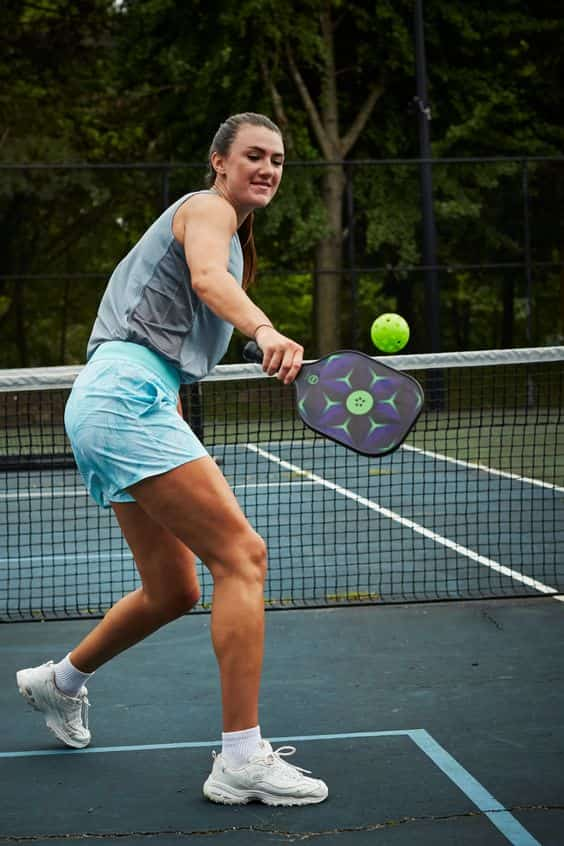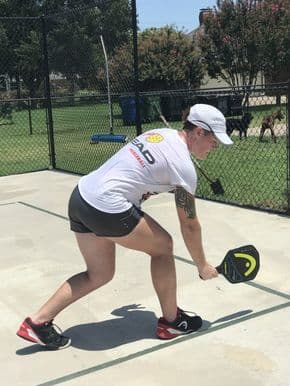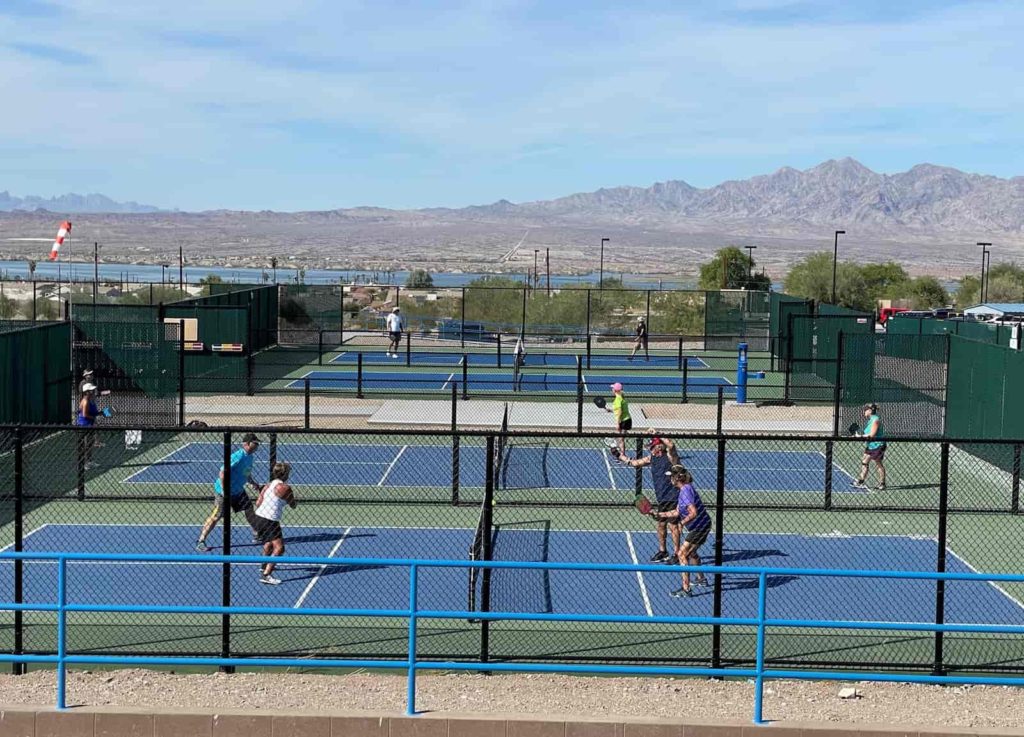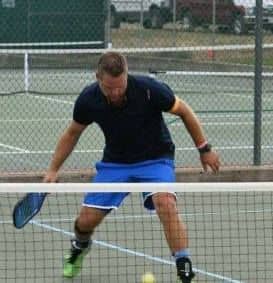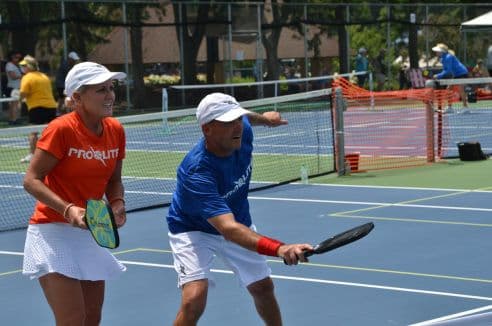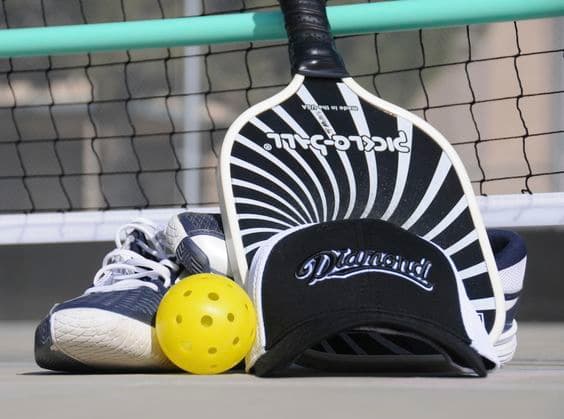The dink Shot Defined
One key shot that distinguishes pickleball from other paddle sports is the dink shot. The dink shot involves gently tapping the ball over the net with just enough force to make it land in your opponent’s non-volley zone without giving them an opportunity to smash it back at you. The dink shot is often considered a finesse shot as opposed to a power move.
It requires soft hands and precise control of the paddle to execute effectively. A well-executed dink can be devastating for your opponent because it forces them out of their comfort zone and often leads to an unforced error on their part.
Why is the Dink Important?
In pickleball, mastering the dink shot is essential for players who want to take their game to the next level. The ability to execute a strong dink will not only allow you to control pace during game play but also help you set up more favorable angles for harder shots like drives or volleys. Moreover, strategically implementing a variety of different dinks can keep your opponents guessing and put them under pressure.
And since many players tend to favor power shots over finesse ones, developing a strong arsenal of dinks can give you an edge on the court. Another reason why mastering this seemingly simple technique is important is that it’s one way of keeping your body healthy while playing pickleball over long periods of time.
Playing power shots all day long can be physically demanding on one’s wrists and arms; however, with the right amount of practice time spent on perfecting this stroke – one would be able to ease some tension off their joints by relying on dinks to win points. The dink shot is an essential technique in pickleball that should be mastered by players of all skill levels.
It may seem like a small part of the game, but its impact cannot be overstated. By perfecting this finesse shot, players can take control of the game and outlast their opponents with precision and patience.
Basic Dink Shot Technique
Pickleball is a game that requires skill and precision, and one of the most important shots in the sport is the dink shot. The dink shot is a short, soft shot that lands just over the net and barely clears the opponent’s reach. In order to execute this shot properly, there are several basic techniques that you should keep in mind.
Proper Grip and Stance
The first step in mastering the dink shot is to have the right grip on your paddle. You should use a relaxed grip with your fingers slightly apart, which will allow you to have more control over your shots. Your stance should also be balanced and comfortable, with your knees slightly bent and your weight evenly distributed between your feet.
Soft Touch and Control
One of the key elements of a successful dink shot is having a soft touch on your paddle. You want to hit the ball gently so that it lands just over the net without going too far or too high.
To achieve this level of control, it’s important to practice hitting different types of shots from various angles. As you become more comfortable with hitting soft shots close to the net, you can also start experimenting with adding spin or changing up your speed to keep your opponents off guard.
Placement and Accuracy
In addition to having a gentle touch on your paddle, it’s also crucial to place your shots accurately when attempting a dink. Ideally, you want to aim for spots on the court where it will be difficult for your opponent to return the ball effectively.
To accomplish this goal, you can try aiming for corners or hitting cross-court shots that force your opponent into an awkward position. As with any other aspect of pickleball gameplay, practice makes perfect when it comes to honing these skills.
Incorporating the Dink Shot into Your Game
Once you feel comfortable with the basic techniques for executing a dink shot, it’s time to start incorporating it into your overall strategy during gameplay. A well-placed dink can set up a powerful smash or force your opponent to make a mistake.
It’s important to remember that the dink shot should be used sparingly and strategically. Overusing this particular shot can actually make you more predictable and easier to beat.
Mastering the basics of the pickleball dink shot requires proper grip and stance, soft touch and control, as well as placement and accuracy. When incorporated thoughtfully into your game, this technique can become an invaluable weapon in your arsenal on the court.
Advanced Techniques for the Dink Shot
Cross-Court Dinks
Cross-court dinks are a vital aspect of the game of pickleball. By hitting cross-court, you force your opponent to run more and cover more ground. This can tire them out quickly and set you up for winning shots.
The cross-court dink shot also allows you to keep the ball away from your opponent’s dominant hand. If they have a strong forehand, hitting cross-court towards their backhand side will neutralize this strength and give you an advantage.
In addition, the cross-court dink shot can be a great setup for an attacking shot. By making your opponent move laterally across the court, you may open up gaps in their defense which can be exploited with aggressive shots.
Execution of Cross-Court Dinks
To execute a successful cross-court dink shot, you need to start with proper footwork. As the ball comes to your side of the court, move towards it quickly and get into position early. Next, focus on keeping your paddle face open and parallel to the net.
Keep your grip light so that you can maintain control over how much power is applied to the ball. As you hit the ball, aim it towards your opponent’s opposite sideline so that they have to run for it.
Your goal is not necessarily to hit it hard but rather place it in a spot where they have difficulty returning it effectively. Practice is essential for mastering this technique – try hitting dozens of cross-court shots during each practice session until you feel confident with this skill.
Drop Shots
Drop shots are another advanced technique used by skilled pickleball players. A drop shot is when you lightly tap or drop the ball just over the net so that it lands in the opponent’s non-volley zone.
The goal of a drop shot is to catch your opponent off guard and force them to hit a weak pop up return. It can also be used as a way to slow down the pace of the game and regain control.
To execute a successful drop shot, start by getting into position early and approaching the ball with your paddle face open. Keep your grip light so that you can maintain touch and control over the ball.
As you make contact with the ball, angle your paddle downward slightly so that it goes over the net but not too high. Be sure not to put too much power behind this shot – it should be softly hit so that it drops just over the net.
Practice drop shots regularly during practice sessions until you feel confident in your ability to execute them consistently. Remember, this advanced technique takes time and effort to master, but once you do, it will make you a formidable pickleball player.
Strategies for Using Dink Shots in Games
The dink shot is one of the most important shots in pickleball, and employing it strategically can be the key to winning a game. Here are some ways to effectively use the dink shot during play:
Setting Up Your Opponent With the Dink Shot
One of the main strategies when using the dink shot is to set up your opponent for a mistake. To do this, you need to make them move around the court by hitting shots that force them out of position. Once they are off-balance, you can hit a well-placed dink that will be difficult for them to return properly.
How to Lure Your Opponent into Making Mistakes
The best way to lure your opponent into making mistakes is by varying your shots and mixing up their pace and placement. For instance, you can start with a hard hit, then follow it up with a soft dink that forces them to rush forward. The more unpredictable you are with your shots, the more likely it is that your opponent will make an error.
The Importance of Patience and Consistency
In order for these strategies to work, you must also be patient and consistent while playing. It’s easy to get caught up in trying to hit hard winners all the time, but this can lead to errors and ultimately lost points. Instead, focus on keeping rallies going by hitting consistent and accurate shots until an opportunity presents itself for a winning point.
The Role of the Dink in Doubles
In doubles play, teamwork and coordination are essential for success. Here’s how incorporating well-executed dinks into doubles play can help control the pace of the game:
Using the Dink to Control the Pace of the Game
Dinks can be especially useful in doubles play for slowing down the game and controlling the pace. By hitting a soft dink, you can force your opponents to come up to the net and make them more vulnerable to attack.
You can then follow it up with a hard hit or lob that they are less likely to return effectively. This will give your team an advantage by keeping your opponents off balance.
Combining the Dink Shot With Other Shots
Another way to use dinks in doubles play is by combining them with other shots such as lobs or overhead smashes. By hitting a well-placed dink, you can draw your opponents closer to the net, opening up more space behind them for a successful lob or smash. This not only makes it difficult for your opponents to return, but also puts pressure on them and forces them into making mistakes.
Mastering the pickleball dink shot is essential for success in both singles and doubles play. By employing these strategies during your game, you’ll be able to set up winning opportunities and control the pace of play, giving you an edge over any opponent.
Conclusion
The Importance of Mastering the Pickleball Dink Shot
The dink shot is a critical weapon in the arsenal of any successful pickleball player. While it may appear simple, mastering this shot requires a combination of finesse, control, and strategy. Whether you’re a beginner or an experienced player, dedicating time to improving your dink shot skills will pay off in spades on the court.
One of the key advantages of mastering the dink shot is its versatility. It can be used to slow down the pace of a game or set up more aggressive shots like smashes and volleys.
Additionally, by forcing opponents to move towards the kitchen line, it can create opportunities for your partner to attack from mid-court. By incorporating dinks into your game plan, you’ll become a more well-rounded player capable of adapting to different situations on the court.
Tips for Practicing and Improving Your Dink
Practice makes perfect when it comes to pickleball dink shots. Here are some tips for honing your technique:
Focus on soft touch and control: The key to a successful dink is hitting the ball with just enough force to clear the net without giving your opponent an opportunity to attack. Practice hitting slow, controlled shots that land within your opponent’s non-volley zone.
Experiment with placement: While many players default to hitting cross-court dinks (which can be effective), don’t be afraid to mix things up by hitting down-the-line or diagonal shots as well. Steep angles tend to work well!
Play with better players: One of the best ways to improve your skills is by playing against players who are better than you. Not only will they challenge you with more difficult shots, but they’ll likely have valuable insights into improving your technique.
Work on consistency: Hitting one perfect dink shot won’t win you the game – it’s about being able to execute the shot consistently. Practice hitting dinks from different positions on the court and in different situations (e.g. after a lob, off a fast-paced return).
By mastering the pickleball dink shot, you’ll become a more formidable opponent on the court. With practice and dedication, this essential shot can take your game to the next level!

